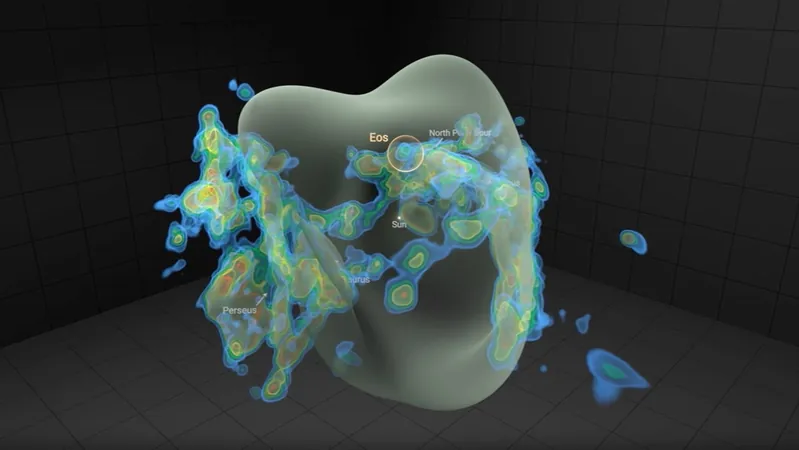
Astronomers Unveil 'Eos': A Massive, Glow-in-the-Dark Cloud Hiding in Space
2025-04-30
Author: John Tan
Discovery of Eos: Our Nearest Molecular Cloud
In a groundbreaking find, astronomers have identified the closest known molecular cloud to Earth, providing an unprecedented glimpse into the cosmic processes that give birth to stars and planets. Named "Eos" after the Greek goddess of dawn, this colossal crescent-shaped cloud of hydrogen gas lies a mere 300 light-years away, stretching approximately 100 light-years wide—equivalent to a staggering lineup of 40 Earth moons.
A Hidden Giant in Our Universe
Blakesley Burkhart, an associate professor at Rutgers University and the study's lead author, expressed astonishment, stating, "It's huge, and it's been hidden for this whole time." Despite its impressive size, Eos evaded detection due to its low carbon monoxide content, a signature chemical typically used by astronomers to locate such clouds. Instead, Eos was discovered through the fluorescent glow emitted by its hydrogen molecules—a novel detection method that might expose other hidden clouds throughout the galaxy.
What Makes Eos Unique?
Molecular hydrogen is the most prevalent substance in our universe, and discovering clouds like Eos enables astronomers to locate previously unseen hydrogen reserves. This could refine our understanding of the materials available for star and planet formation throughout the cosmos. Eos’s discovery was reported in a landmark paper published on April 28 in the journal *Nature Astronomy*.
A Serendipitous Find in Old Data
Burkhart stumbled upon Eos while sifting through data collected over two decades ago from the Korean Science and Technology Satellite-1. This satellite, launched in 2003, mapped hot gas distributions in the Milky Way. Utilizing a spectrograph that breaks down far-ultraviolet light, researchers identified hydrogen emissions, revealing Eos as a structure that is "literally glowing in the dark." Burkhart recalled the moment of discovery: "I was like, 'Huh, I don't know what that is. That's unique.'"
The Formation and Fate of Eos
Intriguingly, Eos has been shaped by its interactions with the nearby North Polar Spur, a vast region of ionized gas originating from the Milky Way's plane. This dynamic interaction is influenced by energy and radiation from this immense feature, likely driven by past supernovae or stellar winds. Simulations predict that Eos could evaporate in roughly 6 million years due to external forces tearing apart its molecular hydrogen reservoir.
Future Exploration of Eos
A future mission is already in the works: Burkhart and her team are conceptualizing a NASA spacecraft named after Eos. This proposed telescope would observe in far-ultraviolet wavelengths, measuring molecular hydrogen in clouds across the Milky Way to better understand star formation and the lifecycle of these cosmic clouds. With many mysteries still to unravel, Burkhart insists, "There's still tons of open questions. We're just getting started."



 Brasil (PT)
Brasil (PT)
 Canada (EN)
Canada (EN)
 Chile (ES)
Chile (ES)
 Česko (CS)
Česko (CS)
 대한민국 (KO)
대한민국 (KO)
 España (ES)
España (ES)
 France (FR)
France (FR)
 Hong Kong (EN)
Hong Kong (EN)
 Italia (IT)
Italia (IT)
 日本 (JA)
日本 (JA)
 Magyarország (HU)
Magyarország (HU)
 Norge (NO)
Norge (NO)
 Polska (PL)
Polska (PL)
 Schweiz (DE)
Schweiz (DE)
 Singapore (EN)
Singapore (EN)
 Sverige (SV)
Sverige (SV)
 Suomi (FI)
Suomi (FI)
 Türkiye (TR)
Türkiye (TR)
 الإمارات العربية المتحدة (AR)
الإمارات العربية المتحدة (AR)